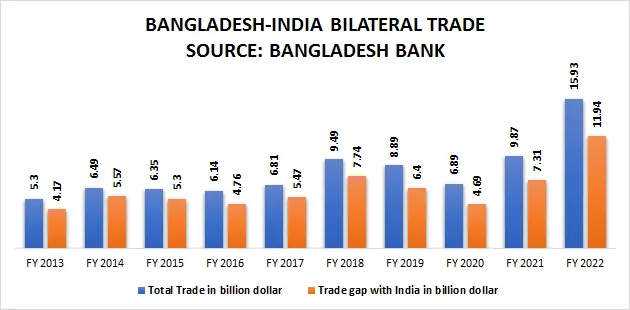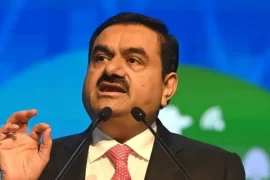India and Bangladesh are neighboring countries that share a unique bilateral relationship, rooted in history, culture, and geography. Over the years, Bangladesh-India trade relations have grown significantly, with both countries becoming important trading partners for each other. However, there are still challenges that must be addressed if the relationship is to continue to grow.
India-Bangladesh Bilateral Trade
India is the second largest trading partner of Bangladesh while Bangladesh is the biggest trading partner of India in South Asia and the fourth largest export destination globally.
In 2021-22, the total trade between India and Bangladesh was worth $16.38 billion, with India exporting goods worth $14.58 billion and importing goods worth $1.8 billion.
According to Bangladesh’s foreign minister Dr A K Abdul Momen ( January 26, 2023), the bilateral trade between the two countries has grown three-fold in the last decade.
However, the trade balance is heavily tilted towards India, and the trade gap is increasing day by day.
India’s Exports to Bangladesh
India exports a variety of goods to Bangladesh, including raw materials, machinery, chemicals, textiles, and automobiles.
The major items exported by India to Bangladesh are cotton, vehicles, iron and steel, machinery, and pharmaceuticals.
Table: India’s export to Bangladesh
[Dated: 21/2/2023; Values in US$ Millions; (P) Provisional; Source: Department of Commerce, India]
| April-Dec, 2021 | April-Dec, 2022 ( Provisional) | Growth | Share of India’s total export |
| 11,021.13 | 8818.60 | -19.98 | 2.62 |
Bangladesh’s Exports to India
Bangladesh primarily exports textile and textile products to India, which accounts for nearly 80% of Bangladesh’s exports to India.
Other major items exported by Bangladesh to India include jute and jute products, leather, seafood, and ceramics.
Table: Bangladesh’s export to India
[Dated: 21/2/2023; Values in US$ Millions; (P) Provisional; Source: Department of Commerce, India]
| April-Dec, 2021 | April-Dec, 2022 ( Provisional) | Growth | Share of India’s total import |
| 1511.03 | 1540.55 | 1.95 | .28 |
Border Trade
Border trade is also an important aspect of India Bangladesh bilateral trade. Border trade between India and Bangladesh takes place through four land customs stations (LCS) – Petrapole-Benapole, Gede-Darshana, Agartala-Akhaura, and Hili-Burimari.
In 2020-21, the total trade through the four LCS was worth $1.31 billion, which was a decrease of 31% from the previous year.
At present, there are 23 land ports between Bangladesh and India, of which 12 are fully operational. Land ports account for over 40% of bilateral trade between the two countries.
Up until now, four border haats have been set up along the Bangladesh-India border, aimed at facilitating cross-border trading among small-scale manufacturers and farmers who reside in close proximity to the border.
Investment Relations
Investment relations between India and Bangladesh have also been growing in recent years. India is one of the largest investors in Bangladesh, with investments mainly in the power sector, textiles, chemicals, and pharmaceuticals.
Indian companies such as Reliance Industries, Tata Group, and Adani Group have invested in various sectors in Bangladesh.
On the other hand, Bangladeshi companies such as Grameenphone, Beximco, and Summit Group have also invested in India. Bangladeshi companies have invested mainly in the textiles, IT, and hospitality sectors in India.
The investment relations between the two countries have been strengthened by the signing of several bilateral agreements, including the Bilateral Investment Promotion and Protection Agreement (BIPPA) and the Double Taxation Avoidance Agreement (DTAA).
BEZA (Bangladesh Economic Zones Authority) is currently making efforts to establish two economic zones for attracting Indian investment. These zones will be located in Mongla and Bangabandhu Shilpa Nagari in Mirsarai, Chattogram.
Several Indian multinational companies such as Asian Paints, Marico, and Sakata have already invested in various economic zones throughout Bangladesh.
Trade agreement between Bangladesh and India
Bangladesh and India signed a trade agreement on June 6, 2015, during Modi’s visit to Bangladesh. The agreement stipulates, ” Each Government shall accord to the commerce of the country of the other Government, treatment no less than that accorded to the commerce of any third country.” This agreement would be extended automatically for successive terms of five years unless either government terminates it.
Does India have a free trade agreement with Bangladesh?
Currently, there is no free trade agreement between Bangladesh and India. But both countries are signatories to SAFTA. The South Asian Free Trade Area (SAFTA) was established as the free trade agreement of the SAARC in 2006, succeeding the 1993 SAARC Preferential Trading Arrangement. SAFTA acknowledges the necessity for special and differentiated treatment for Least Developed Countries (LDCs) in its preamble, which is implemented through the following measures:
Regarding market access, LDCs are provided with smaller sensitive lists in some of the SAFTA members, which implies that they have a larger number of products that have duty-free and quota-free (DFQF) access, along with less rigid rules of origin. The rules of origin require a change of tariff heading and value addition of 10% less than the general requirement for non-LDCs. For non-LDCs, the general rule is 60%, and there are some product-specific rules to follow, which can be found in Rule 10 of Annex IV of the SAFTA agreement.
Bangladesh and India are currently engaged in talks to finalize the Comprehensive Economic Partnership Agreement (CEPA).
CEPA is expected to be more than a free agreement as it will cover investment, trade in services, development of trade infrastructure, etc.
Trade connectivity infrastructure
Bangladesh and India have been working together to increase the flow of goods and services by strengthening road, rail, and waterway infrastructure.
One of the most significant connectivity projects is the India-Bangladesh Protocol on Inland Water Transit and Trade, which was signed in 1972 and updated in 2015. This protocol allows for the movement of goods between the two countries via inland waterways.
The recent establishment of a direct sea route between India’s Krishnapatnam Port and Bangladesh’s Chittagong Port has also facilitated the movement of goods and lowered transportation costs.
Bangladesh and India have several operational rail links including Petrapole-Benapole, Gede-Darshana, Radhikapur-Biral, and Singhabad-Rohanpur.
The old railway link between Chilahati (Bangladesh) and Haldibari (India) has also been reestablished after 56 years. A goods train travelled from Haldibari to Chilahati on August 1, 2021.
Another important rail project is the construction of the Akhaura-Agartala rail link, which will provide a direct rail link between India’s Tripura and Bangladesh. A plan is in place in India to construct an integrated check post and cargo handling facility at Nischintapur, which is the meeting point of the Agartala-Akhaura rail link in the state of Tripura. The Akhaura-Agartala project is expected to boost trade and tourism between the Northeastern states of India and Bangladesh.
In addition to the rail link, the Maitri Setu ( Friendship Bridge) over Feni River has connected Ramgarh of Bangladesh with Tripura’s Sabroom which will create access for landlocked Tripura to Bangladesh’s Chattogram Port.
Besides the provision of regular train services, bus transportation is available between different parts of India and Bangladesh.
The newly built Padma Multipurpose Bridge is expected to play an important role to enhance cross-border trade between India and Bangladesh.
India has also shown interest in investing in new airports to strengthen air connectivity between Bangladesh and India’s north east.
Challenges in Bangladesh-India Trade Relations
Despite the many successes in the India-Bangladesh bilateral trade, there are still challenges that both countries must address.
One of the most significant challenges is the issue of non-tariff barriers, which includes technical standards, quality requirements, and other regulations that can limit trade.
On December 30, 2022, India extended anti-dumping duties (ADD) on various jute products from Bangladesh for an additional five years. The ADD on jute products has been seriously damaging Bangladesh’s jute industry.
There is also the issue of infrastructure, as many of the roads and railways connecting the two countries are in poor condition.
Potentials of Bangladesh-India Trade Relations
However, there are also significant opportunities for growth in the Bangladesh-India trade relationship. The increasing economic ties between the two countries are a positive development, as both India and Bangladesh are growing rapidly.
There is also the potential for increased cooperation in areas like energy and security, which could lead to greater trade and investment between the two countries.
Read also: Bangladesh’s export opportunities in India
One major area of trade cooperation can be cotton. As a significant cotton-producing country, India can supply cotton to Bangladesh, whose primary export sector is apparel. Exporting finished products to India can help Bangladesh reduce the trade gap with her big neighbour.
There is also significant potential for growth in the pharmaceutical industry. Bangladesh is already a major exporter of generic drugs, and India is one of the largest producers of pharmaceuticals in the world. By working together, the two countries could become even more significant players in the global pharmaceutical industry.
Another potential area for increased Bangladesh-India trade is the agricultural sector. India is a major producer of rice and wheat, while Bangladesh is a major producer of jute and tea. By increasing cooperation in the agricultural sector, the two countries could become more self-sufficient and better able to meet the needs of their populations.
The logistics facilities at land ports need to be improved.









